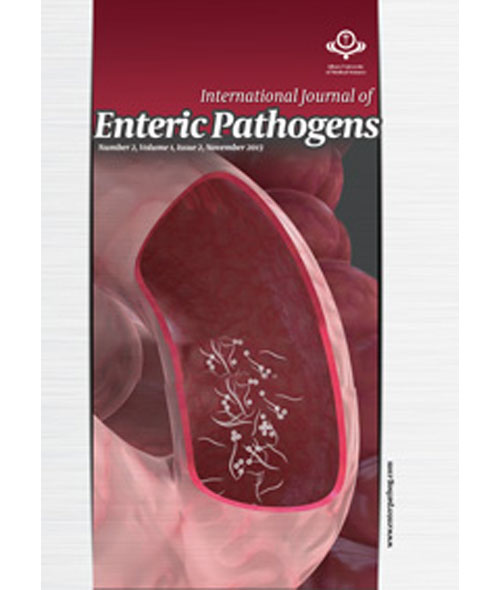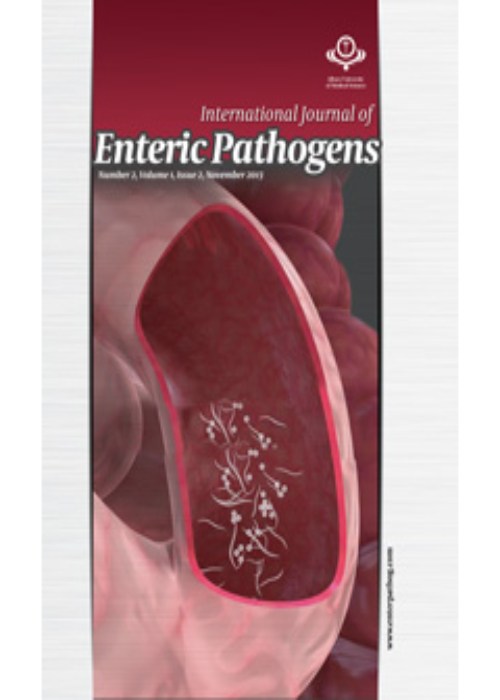فهرست مطالب

International Journal of Enteric Pathogens
Volume:6 Issue: 1, Feb 2018
- تاریخ انتشار: 1396/12/26
- تعداد عناوین: 7
-
-
Pages 3-9Persian walnut (Juglans regia L.) is a nutritionally rich and also popular nut which is largely consumed throughout the world. In addition to dry fruits (nuts), green walnuts, kernels, shells, green walnut husks (epicarp), barks and leaves have been applied in both cosmetic and pharmaceutical industries. Since ancient times, it has been used in folk medicine for treatment of several diseases and disorders such as diabetes, cancer, skin disease and infections, rheumatoid arthritis. In recent decades, many experimental researches have been done on the composition and characteristics of different parts of Persian walnut tree. These researches showed that walnut has many nutritious components such as phenolic component, unsaturated fatty acids and minerals essential for human health. Using walnut in folk medicine and identification of beneficial components of this fruit prompted many scientists to investigate properties that have traditionally been attributed to this fruit and the researches done in this area showed that walnut has effective antioxidant, antimicrobial, antitumor and anti-inflammatory properties that make it a promising drug for associated diseases.Keywords: walnut, folk medicine, fatty acids, antioxidant
-
Pages 10-13Context: Anthrax is a zoonotic and occupational disease caused by bacterium Bacillus anthracis. The agent produces spores which persist in the environment for years. This review assessed previous reports on anthrax disease in Iran from 2000 to 2016.
Evidence acquisition: The reports of anthrax from 2000 to 2016 were reviewed. The keywords "Bacillus anthracis", "Anthrax", "clinical signs", "Iran" and "zoonosis" were investigated in the searching databases such as "Google Scholar", "Google", "PubMed" and other sites. The reports of soil isolation and spores from environments were excluded. However, the clinical outcome of the cases, history of animal exposure, wool contaminations and meat in slaughterhouses were included. Results of Persian reports were also included in this review. Data were analyzed using Excel and GraphPad Prism version 6.1. The standardized mean difference (SMD) was used for data analysis.. Overall, 768 cases of anthrax were found in human, sheep, goats and cattle. Six hundred of the human cases aged between 2.5 and 71 years old were included. Four-hundred ten (68.33%) patients were male (mean age=28.1 ± 1.5) and 190 (31.66%) patients were female (mean age = 17±1.5). Clinical manifestations in patients were mostly in 2 cutaneous (56.6%) and gastrointestinal (42.83%) forms. Sporadic anthrax outbreaks occurred in the country in 2007, 2008 and 2011. No molecular typing has been performed for B. anthracis strains countrywide. The virulence factors encoded by the genes located on plasmids pXO1 and pXO2 were detected in various areas with high prevalence.ConclusionCutaneous and gastrointestinal anthrax are 2 main manifestations of the disease in Iran. Male patients were significantly more infected. Although rare, anthrax continues to be a dreadful consequence of herds or soil exposure and consumption of undercooked meat of infected animals. Education plans and proper animal vaccination plans with the consideration of virulence factors are helpful for the prevention of the disease.Keywords: Bacillus anthracis, anthrax disease, cutaneous anthrax -
Pages 14-17BackgroundCattle transiently harbor Shiga-toxigenic Escherichia coli (STEC) in their gastrointestinal tracts, and many human infections result from ingestion of contaminated dairy products. The occurrence of STEC infections in human ranges from mild watery diarrhea to life-threatening conditions such as thrombotic thrombocytopenic purpura, hemorrhagic colitis (HC) and hemolytic uremic syndrome (HUS).ObjectiveIsolation of STEC from unpasteurized dairy products as a source of human infections is the aim of this research.Materials And MethodsIn this study, after collecting 150 samples of unpasteurized dairy products from different parts of Ahvaz, primary enrichment, selective enrichment and conventional biochemical tests were done and the suspected DNA isolates were extracted by boiling. Confirmation of being toxigenic isolates was performed by multiplex polymerase chain reaction (mPCR) assay. The stx1- and stx2-specific primers were used in m-PCR.ResultsOut of 75 isolates with lactose-fermentation ability, 11 E. coli strains were confirmed by biochemical tests. Two isolates (18.18%) were detected as carriers of stx2 gene by PCR.ConclusionBecause of low infective dose, the presence of a low percentage of toxigenic E. coli in dairy products could be a grand public health risk, while the bacteria other than E. coli could be producing Shiga toxin which should not be ignored.Keywords: shiga- toxigenic Escherichia coli, polymerase chain reaction, dairy products
-
Pages 18-21BackgroundYersiniosis is a common foodborne infection caused by Yersinia enterocolitica. This bacterium is frequently isolated from animals. Generally, bacteriophages (phages) are viruses that only infect bacteria, and are ubiquitous in the world including the intestinal tracts of animals and sewage. Today, due to the development of antibiotic resistance among bacteria, studies on phages have been considered as a controlling factor for bacterial infections.ObjectiveThe aim of this study was to identify and isolate Y. enterocolitica, the bacterium-specific phage, from raw sewage.Materials And MethodsEvery 10 minutes, 6 samples each containing 30 mL raw wastewater were collected from the sewage treatment center of Vali-asr hospital, Tehran-Iran. Bacteriophage was isolated from sewage samples using Double-Layer Agar method. In addition, the samples were purified and the volume required for the isolation of bacteriophage was determined. Then, we investigated the sensitivity of the isolated bacteriophage to the temperature.ResultsLytic bacteriophages were isolated from the samples obtained from hospital sewage. This bacteriophage was largely active on Y. enterocolitica. It was active at 4, 22, 37, 40, 50, 60, and 70°C, however it became inactive at 80°C.ConclusionThe results showed that Y. enterocolitica specific bacteriophage could be isolated from hospital sewage samples.Keywords: Yersinia enterocolitica, bacteriophage, wastewater
-
Pages 22-26BackgroundGenital infections are among the most common diseases for which women refer to gynecologists. Vulvovaginal candidiasis is the second most common infection among women.ObjectiveA few studies have been conducted on new therapeutic regimens improving the effectiveness of current medications; accordingly, the present study was conducted to compare the effectiveness of clotrimazole with clotrimazole plus probiotics in the treatment of vulvovaginal candidiasis.Materials And MethodsThe present double-blind clinical trial was conducted on 80 women admitted to Shohada hospital in Tehran in 2014. The participants were randomly divided into 2 groups of clotrimazole and clotrimazole plus probiotics. The collected data included the participants sociodemographic information and their medical records along with their symptoms and laboratory results before and after the treatment. Finally, the collected data were analyzed using chi-square test, t test, McNemar test and Fisherexact test.ResultsThe results showed that both treatments (i.e. clotrimazole and clotrimazole plus probiotics) are equally effective in the treatment of vulvovaginal candidiasis (P = 0.499).ConclusionThe results of the present study indicated that supplementing clotrimazole with probiotics results in similar effects compared to administering clotrimazole alone in the treatment of vulvovaginal candidiasis.Keywords: Vaginal candidiasis, Lactobacillus, Clotrimazole, Probiotics
-
Pages 27-30BackgroundThe presence of extended-spectrum β-lactamases (ESBLs) is increasing worldwide and blaCTX-M1 is the predominant β-lactamase.ObjectiveThis study was conducted to determine the ESBL production and prevalence of blaCTX-M1, blaSHV and blaTEM and AmpC genes and repetitive extragenic palindromic polymerase chain reaction (rep-PCR) pattern among Klebsiella pneumoniae isolates in Tehran from 2014 to 2016.Materials And MethodsOne hundred eleven isolates were collected during the study period. The PCR was employed to detect the blaCTX-M1, blaSHV, blaTEM and AmpC genes. The genetic relation of isolates was performed using rep-PCR typing method.ResultsEighty-three and 86 isolates showed Minimum inhibitory concentration (MIC) ≥2 against ceftazidime and cefotaxime, respectively and 80 (72%) isolates exhibited ESBL production. The prevalence of blaCTX-M1, blaSHV, blaTEM and AmpC genes among ESBL producers was 92.5% (n = 74), 66.2% (n = 53), 56.2% (n = 45) and 2.5% (n = 2), respectively. The rep-PCR typing pattern of isolates showed a wide diversity, indicating the polyclonal spread of CTX-M type producing isolates.ConclusionThe findings of this study highlighted the emergence and spread of K. pneumoniae isolates producing CTX-M and other ESBL enzymes with diverse genetic backgrounds in a hospital in Tehran.Keywords: Klebsiella pneumoniae, Extended Spectrum β-lactamases, rep-PCR typing


